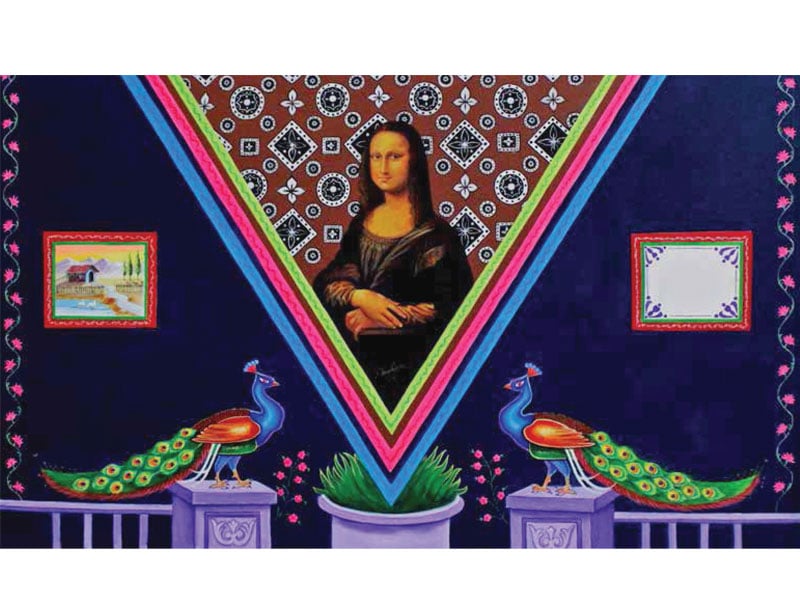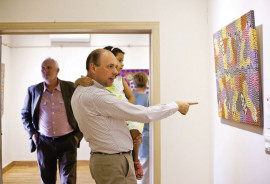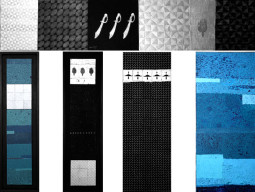
KARACHI:
In previous years, the Koel Gallery celebrated its anniversaries with shows focusing on a particular theme or style — self-portraits, for instance, or specific colours. But for its fifth year curators, Noorjehan Bilgrami and Muhammed Zeeshan, went for a geographical connection instead of a thematic one.
Sixty-six works by 57 Sindhi artists are currently on display in the gallery and they run the gamut of styles and subjects. Titled 'Sindh — reverberating sounds echo through the desert…' the collection features everything from idyllic landscape paintings to highly abstract, expressionistic works.

Abdul Malik Channa’s ‘The friends’ PHOTOS: COURTESY KOEL GALLERY
"The profiled artists belong to the same tradition, culture and soil," it says in the curatorial note, but the show by no means tries to define one unifying element that binds these Sindhi artists together. Instead the collection celebrates the diversity and eclecticism that is evident across the collection.
'Mona Lisa in Sindh' by Mohan Das, who depicts a portrait of the iconic female figure on the back of a rickshaw, perhaps best captures how many contemporary Sindhi artists are inspired by both local and international sources. Many artists and designers draw inspiration from truck art, to the extent it has become rather trite, but for Das, who focuses very specifically on rickshaws and not trucks, this is not a gimmick of any sorts.
As a child he used to paint rickshaws in his hometown of Hyderabad and the reference to the Italian master Da Vinci is not arbitrary either. The first rickshaw, Das explains, came to Sindh from Italy in 1961 and the slogan 'Italy ki shehzadi, Sindh ki goud mein' was often painted on the backs of the early rickshaws.

GN Qazi’s ‘The Bell’.PHOTOS: COURTESY KOEL GALLERY
In complete contrast to the bold colours and striking composition of Das's painting, was Naveed Sadiq's 'Natteja.' Also from Hyderabad, Sadiq went on to study miniature painting at the National College of Arts in Lahore and while his style is firmly rooted in the Persian miniature tradition, the overlapping bovine figures and sandy hues bring to mind scenes from rural Sindh.
Miniature art figured prominently in the exhibition with internationally renowned artist Imran Qureshi's 'Easy Cutting' also on display. The delicate filigrees on the small canvas are much like the ones he earlier painted on the rooftop of the Metropolitan Museum of Art in New York and in the courtyard of Bait Al Serkal in Sharjah. Here though, blue features more prominently than red but the presence of scissors and incision-like marks still suggests violence.

‘Easy Cutting’ by Imran Qureshi. PHOTOS: COURTESY KOEL GALLERY
Rehana Mangi, who was born in Larkana, also takes a modern take on miniature art. In her two works, she stitches with hair over the paper, to either create a form (as seen in 'Popet') or to obscure the images already painted on the canvas ('Untitled'). Mangi has long been fascinated by human hair, especially how it is associated with black magic once it falls. From a distance the works do not seem particularly extraordinary. It is only when you come up close and see the stitched butterfly against the backdrop of gold-leaf or the grid of hair overlying a miniature painting does the subversive nature of the artwork become apparent.
On the other end of the spectrum were the expressionistic works done on large canvasses. Arif Hussain Khokar's 'Within the Space' with its frenzied scribbles done in oil pastels brought to mind works by Jackson Pollack and Cy Twombly.

Rehana Mangi’s work with human hair, Gouache, tea wash and gold leaf on wasli PHOTOS: COURTESY KOEL GALLERY
Shaukat Ali, who comes from the small village Mithodero, layers words over in each other in 'Meditation' until they become undecipherable. He writes in his artist's statement about how words are manipulated in public spaces and as with many of the works in the show, his art is politically-charged and incisive.
Published in The Express Tribune, April 19th, 2014.






















































COMMENTS
Comments are moderated and generally will be posted if they are on-topic and not abusive.
For more information, please see our Comments FAQ